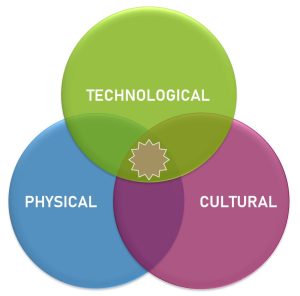By Guy Osmond
In last month’s blog, I outlined the Three Phases of Workplace Accommodation being addressed by employers seeking stability during and after the COVID19 pandemic. In this article, I look to the future to consider the issues all employers need to address. I also look at ways to accommodate the very different needs of a dispersed workforce. Of course, there will be some organisations who bring everyone back into their original workplace but we expect this to be a small proportion. Most businesses have been pleasantly surprised by the ease with which home working has been adopted and behaviours adapted.
Whilst home working generally seems to be a success at enterprise level, the response of individuals is more diverse. We already see growing numbers of complaints about musculoskeletal issues and there has been widespread publicity about stress and mental health concerns. We must also remember that we have had generally good-to-glorious weather with long days, little rain and strong light. How different may this feel in the shorter days of a British autumn and winter with cold, rain or fog outside?
Employers are already considering what actions to take about physical health complaints and reviewing wellbeing programmes to accommodate mental health needs but these actions in isolation will not address the much bigger issue: how do we take advantage of the impetus created by enforced home working arrangements and build a better organisation as a result?

My favourite way to look at this is by considering the WorkNet – the move from a box to a network – a concept created by Stephanie Akkaoui Hughes of AKKA Architects (see The New Workplace). As Stephanie points out, interactions are the origin of ideas and the basis of relationships. In a contained workplace, they happen naturally at the desk, in the corridor, in meeting rooms or at the coffee machine. Indeed, architects and designers create canteens, touchdown areas and other spaces specifically to foster such encounters. How do you facilitate these interactions and encourage this creativity in the new WorkNet?
This requires a multi-disciplinary approach and must therefore be managed at a strategic level. Every employer will have key personnel responsible for Estates, Facilities, Health & Safety, HR, Human Factors, IT and Occupational Health. Each of these disciplines will contribute to the discussion and provide valuable insight into the facilitation process.
The shared objective must be to create and maintain an engaged, happy workforce where each individual can find that central intersection of the Venn diagram that works for them personally and they want to be there. The significant difference now is that we may never see the physical location (or locations) that those individuals use so the WorkNet must be even more supportive than the old Workplace. We also need to be thinking, not just of office and home, but the other possible locations such as coffee shops, hotel lobbies, work hubs and shared spaces.
Over many years, we have worked with experts in all these areas and we have created a short list of primary issues.
- Physical Health
- Mental Health
- Lifestyle Health
- Resilience
- Communications
- Empowerment
- Engagement

The CIEHF provides guidance on creating a systems framework for such projects and ISO27500 – The Human Centred Organization (well-described in this recent piece) is an excellent place to start.
We have also put together a team of specialists who can deliver all the essential stages and, if required, provide ongoing support to maintain the culture and those essential interactions.
Please contact me to explore this further or for a preliminary discussion about how your own organisation might approach this. I am also giving more detail in this webinar.